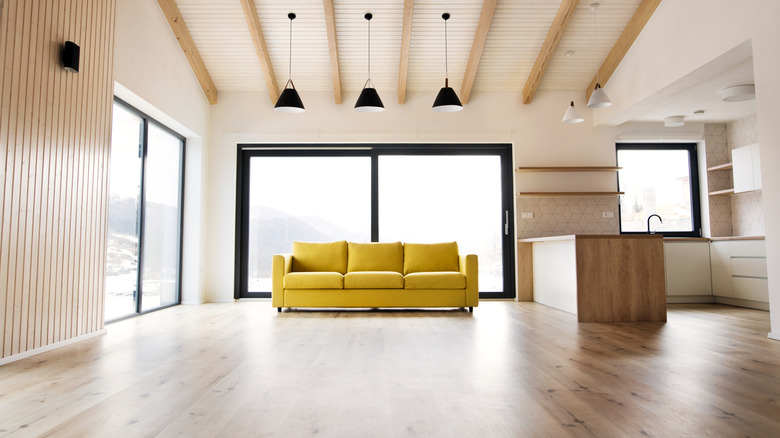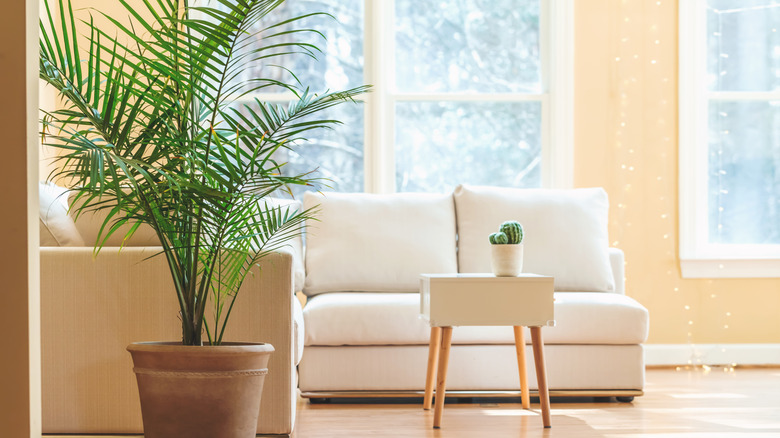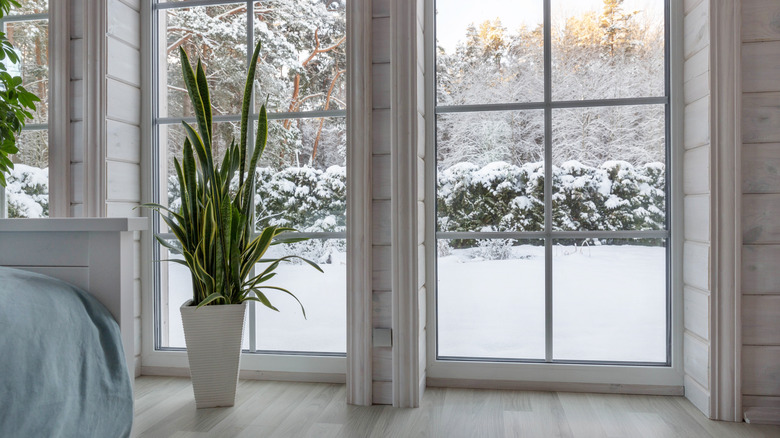The Best Indoor Plants To Use To Fill Out Space In A Large Planter
Bringing plants into your indoor space has several benefits that reach far beyond aesthetics. They can reduce your stress, help you stay more focused, boost your productivity, help you heal, increase your positivity, and scrub contaminants right out of the air inside your home. And adding a large indoor plant – or several – can bring about even more benefits. They can not only fill in empty spaces and add a focal point to your room, but you can even use them to separate spaces in your house. While you might know how to pick the perfect indoor plants for small spaces, big plants need some elbow room. Some of the best large houseplants you could choose to fill your space include the bird of paradise (Strelitzia reginae, snake plant (Sansevieria trifasciata), Swiss cheese (Monstera adansonii), weeping fig (Ficus benjamina), red-edged dracaena (Dracaena marginata), majesty palm (Ravenea rivularis), rubber tree (Ficus elastica), and elephant ears (Alocasia spp.).
But before you add any of these plants to your home, there are some considerations you need to keep in mind. For example: Do you have any pets? If so, note that most of the above choices have varying degrees of toxicity when consumed. In that case, you might want to lean toward large non-toxic plants like bamboo palms (Chamaedorea seifrizii) or kentia palms (Howea forsteriana). Also, think about the space you're trying to fill, its proximity to the light, and how easy the plants are to care for. Those looking for greenery without the hassle might choose the easiest houseplants that anyone can keep alive or ones that even beginners can grow that will still work in the space.
Aesthetics and strategic placement of large houseplants
When choosing among the best large indoor plants, one of the first things you want to consider is the leaf shape and size. Do you want tall, thin leaves, spiky ones, shiny foliage, a tree, or a plant that looks straight out of the tropics? Then, look at the space you want to fill. Snake plants are slender and tall with green leaves and yellow edging, while elephant ears have huge green leaves that drape and take up a lot of room. If your chosen area is near the television or a fireplace, draping elephant ears might not be the best choice. In those cases, the snake plant would fit better. Another choice for those particular spots is the majesty palm. While this lovely addition sprouts many large feathery fronds, the palm grows surprisingly upright. On the other hand, an empty corner of the room might call for a plant that can fill the area with its volume. That may be where your elephant ears, weeping figs, or red-edged dracaenas could find a home.
Light requirements also come into play when picking which plant goes where. A corner that barely gets any light isn't suited for a Swiss cheese because it prefers a bright spot and won't appreciate the dark. Instead, find a nice spot near the window for this beauty. Bird of paradise plant and majesty palm have similar light needs and won't work there either, but a rubber tree can tolerate low light, so that might be your best bet. Before picking a plant to fill that open space, observe how the light hits the area and choose one that will thrive there.
The best care for the best large plants
While all the plants on this list are large, how big do they get? Bird of paradise can reach an impressive 8 feet tall. Water it regularly and place it in bright light for best results. Snake plants are hardy, can reach up to 4 feet, and will tolerate nearly any light level as long as they have well-drained soil. Place this plant anywhere. Housed in the right-sized pot, the Swiss cheese plant can reach 15 feet and spread up to 8. If you need to fill a large empty space near a window, this is your pick. Weeping figs grow to be 6 feet tall. Repotting it to slightly larger pots annually will help them reach their potential. Give them bright indirect light and rich, well-draining soil.
Next on the list is red-edged dracaena. This easy-to-care-for plant could be kept to 6 feet or less if well pruned. It can spread a few feet wide, so ensure you have the space. This pick prefers bright, indirect light and well-drained, loose soil. Be careful not to overwater it, though. It's no surprise that tropical majesty palms love humidity, so mist it liberally. This tree can grow up to 12 feet tall and will tolerate medium light. Rubber tree plants are known for their large, deep, green, shiny leaves. This interesting fellow can grow to 10 feet and tends to take up a bit of space in width if allowed multiple trunks. It would gladly brighten a lowly-lit corner. Looking to fill a space in the bathroom? Elephant ears can grow to 6 feet, adore humidity, and would love it in there, as long as they receive bright indirect light.


